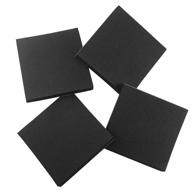🧼 Foam
The Fascinating World of Foam: Unveiling the Ingredients, Suppliers, and Manufacturing Process
When it comes to industrial and scientific products, foam plays a vital role, providing insulation, cushioning, and structural support. From mattresses to packaging materials, foam is a versatile material that finds its way into various applications. Behind the scenes, a world of polyurethane foam ingredients, expanded polystyrene suppliers, and foam manufacturing chemicals comes together to create this remarkable substance. Let's dive into the intricate world of foam and explore its components, sourcing, and production process.
The Key Players: Polyurethane Foam Ingredients
Polyurethane foam, one of the most common types of foam, owes its unique properties to a combination of ingredients. These ingredients include polyols, isocyanates, catalysts, and blowing agents. Polyols are the backbone of polyurethane foam and contribute to its flexibility and resilience. Isocyanates, such as toluene diisocyanate (TDI) and methylene diphenyl diisocyanate (MDI), act as crosslinking agents, forming the foam's structure. Catalysts help initiate the chemical reactions that lead to foam formation, while blowing agents generate the characteristic bubbles or cells within the foam, resulting in its lightweight nature.
Exploring the Supply Chain: Expanded Polystyrene Suppliers
Another type of foam widely used in various industries is expanded polystyrene (EPS) foam. EPS is a lightweight, rigid foam composed of polystyrene beads fused together. It is known for its excellent insulation properties, making it ideal for applications like packaging, construction, and thermal insulation. To meet the demand for EPS, a network of dedicated expanded polystyrene suppliers plays a crucial role. These suppliers source raw polystyrene material, expand it using specialized equipment, and supply it in various forms, such as sheets, blocks, or molded products, to industries worldwide.
The Chemistry Behind the Magic: Foam Manufacturing Chemicals
The process of foam manufacturing involves a delicate balance of chemical reactions and physical processes. Foam manufacturing chemicals play a pivotal role in achieving the desired foam properties. In addition to the polyurethane foam ingredients mentioned earlier, other chemicals come into play. Surfactants, for instance, reduce the surface tension of the liquid components, allowing them to mix evenly. Stabilizers help maintain the foam structure over time, preventing the breakdown of cells. Flame retardants can be added to enhance fire resistance, ensuring safety in certain applications. Each chemical contributes to the foam's final properties, making it suitable for specific industrial or scientific needs.
Conclusion
Foam, a ubiquitous material in industrial and scientific products, owes its versatility to a fascinating blend of ingredients, dedicated suppliers, and carefully chosen manufacturing chemicals. Whether it's the polyurethane foam ingredients providing flexibility and resilience, the expanded polystyrene suppliers meeting the demand for lightweight insulation, or the foam manufacturing chemicals fine-tuning the properties, each element plays a vital role in creating the foam we rely on daily. Next time you encounter foam, take a moment to appreciate the intricate science and engineering behind its creation.


7 Review
【Self Adhesive Foam Sheets】These foam sheets are made from Neoprene. Resistant to high and low temperatures, can be used from -50°C to 150°C. 【Closed Cell Neoprene】Closed cell neoprene foam sheets has excellent properties such as impact resistance, deformation resistance, flexibility, shock absorption, non-slip and insulation. 【High Density】Weather proof…
Read more about this product
